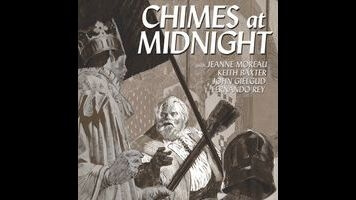“Jesus, the days that we have seen,” whistles the voice of skinny Robert Shallow as he shuffles up a snow-covered slope, followed a few paces behind by the teetering outline of Sir John Falstaff. Against the whiteness of the snow, these two old men resemble silhouettes of black ink escaping a sheet of paper, framed through rocks and gnarled trees that hold down the foreground like paperweights. The scene suggests a writing desk, but also a purgatory of abandoned art—a Pieter Bruegel snowscape, depopulated except for two stragglers. And who is this we, anyway? Is it just these two discarded characters, or the whole legendarium of Shakespeare? The best and most touchingly personal of all Shakespeare adaptations, Chimes At Midnight is pervaded by melancholy and loneliness, even though its characters are almost seen never alone.
Cut and pasted from the texts of five different plays (plus snippets of Holinshed’s Chronicles, the Bard’s main source on English history), Chimes At Midnight puts larger-than-life John Falstaff, Shakespeare’s most popular comic role, center-stage, only to dwarf him with cathedral and castle interiors. Orson Welles made innovative use of low angles in his debut, Citizen Kane, reinventing ceilings as backdrops; here, in his final trip into the corridors of power, they seem so far above as to be unreachable. Even Chimes At Midnight’s brutal, celebrated Battle Of Shrewsbury sequence—a hurricane of medieval violence that has remained a key Hollywood reference point for decades—finds time to cut back to Falstaff, wobbling around in a suit of armor like a lost astronaut roaming the moonscape of history. A big chunk of Welles’ body of work could be divided up into movies about power (e.g. Citizen Kane, Macbeth) and movies about powerlessness (e.g. The Lady From Shanghai, The Trial), and Chimes At Midnight fits squarely into the latter category.
By turns wistful and raucous, Chimes expands Welles’ lifelong self-identification with Falstaff—the fat troublemaker with the big ego, who parties with royalty, but is ultimately fated for rejection—into a fully realized vision of the character as a tragic figure. Looking like a mall Santa who spends his nights in the drunk tank, Welles’ Falstaff holds court in the Boar’s Head Tavern—an over-sized, multi-level set that resembles a theater, complete with stage and catwalk—surrounded by thieves, ladies-of-the-night, and dissolute young men, including Prince Hal (Keith Baxter), son of Henry IV (John Gielgud) and the heir to the throne of England. Though mostly celebrated as a technical show-off, Welles was drawn to stories of loss and abandonment from early on; even Citizen Kane, which premiered when he was all of 25, is largely about memory. Chimes ranks alongside The Magnificent Ambersons as one of Welles’ most sensitive exercise in this theme, in part because it’s told from the point of view of the abandoned.
Put in the terms of the multi-hyphenate filmmaker’s most famous work, Falstaff is the childhood sled that will be thrown into the fire (or, in this case, put in the ground) by a couple of anonymous workmen. With typical gusto, Welles lays out this tragedy of betrayal through ingenious compositions, staged in architectural spaces so deep, they register as optical illusions. Crisscrossing camera moves and cuts hidden by passing figures visualize the Boar’s Head as a funhouse of constant movement, contrasted by the inhospitable geometries of the throne room. As in so much of Welles’ work, the dubbed dialogue is mixed like a radio play, creating a heightened sense of sonic space, as though the characters were whispering in the audience’s ear. Soliloquies are rewritten as monologues; for Welles, backdrop is half of drama, and everything happens against something. Especially loneliness.
Completed in 1965, Chimes At Midnight is the last major narrative work Welles completed in his lifetime, though not for lack of trying. And like so many of the movies he made (or attempted to make) during the last part of his career, it’s been tied up in rights disputes for decades, making it effectively unknown in America outside of critical and filmmaking circles. Now returning to American screens in a Janus Film restoration, it’s more than just an overlooked item ripe for rediscovery—it’s an essential, and the movie against which all other Shakespeare adaptations should be measured, inventive and expressive in its approach to text, and consistently surprising and creative as filmmaking, conjuring its own medieval world out of a few dozen extras and some mud-splattered Spanish locations.

